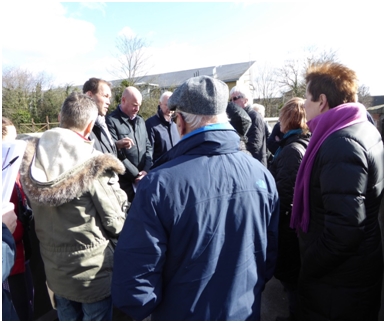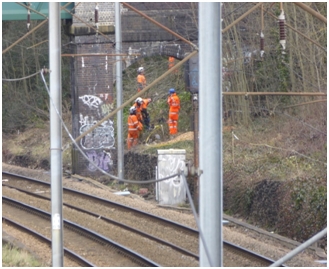Palmers Green residents who are angry with the wholesale removal of trees from a trackside cutting have begun sending messages of protest to a Network Rail manager.
 Complaints relate to a section of track adjacent to the Fox Lane bridge. On the western side of the cutting absolutely all trees and bushes have been removed along the section of track next to the new "Palmadium" housing development. Quite apart from the visual impact, there will be an obvious severe affect on wildlife and more train noise for Palmadium residents. It will also now be much easier for people to trespass on the railway line. There are also concerns about a risk of landslips onto the railway - as happened only recently in Warwickshire when trees were removed, leading to the closure of part of the Marylebone-Birmingham line until further notice.
Complaints relate to a section of track adjacent to the Fox Lane bridge. On the western side of the cutting absolutely all trees and bushes have been removed along the section of track next to the new "Palmadium" housing development. Quite apart from the visual impact, there will be an obvious severe affect on wildlife and more train noise for Palmadium residents. It will also now be much easier for people to trespass on the railway line. There are also concerns about a risk of landslips onto the railway - as happened only recently in Warwickshire when trees were removed, leading to the closure of part of the Marylebone-Birmingham line until further notice.
Example of a message sent to Network Rail executive Richard Owens (Richard.Owens@networkrail.co.uk)
Hello Richard,
I’m sure you’ve received a few emails like this today and that there’ll be more to follow in the next few days, as a resident has provided before and after pictures for those of us trying to get to the bottom of the current clearance.
The flattened area around the Fox Lane bridge area highlights exactly the kind of wholesale destruction I was worried about when I contacted you earlier this month.
I’m sure there’s nothing you’ll say in response except that you were actioning the recommendations of an independent survey; though I’m still finding it hard to shake the conviction that Network Rail’s brief for the survey was something along the lines of ‘please highlight any and all possible threats, no matter how small, that might conceivably affect the lines for many years to come’.
Can all of these trees have posed a threat to the line? Really?
I realise also that Network Rail are in the privileged position of not being answerable to anyone - that much has been made abundantly clear. But please bear in mind that though you own the land around the tracks, the wildlife and trees there are part of our environment, and a little consideration for the feelings of residents when you’re planning this sort of excessive clearance might be worth considering. Would you tolerate this in your neighbourhood?
After Network Rail gave notice of the tree clearance project, attempts by Enfield Southgate MP David Burrows and others to forestall any particularly drastic interventions were unsuccessful - a reflection of Network Rail's privileged legal status with regard to the way it manages its land.
 The arboriculturalists' report provided to Network Rail referred to two groups of trees at the point in question, using the reference TG3026 and TG3027.
The arboriculturalists' report provided to Network Rail referred to two groups of trees at the point in question, using the reference TG3026 and TG3027.
TG3026 referred to two horse chestnuts "displaying typical symptoms of horse chestnut bleeding canker infection, damage to lower stems becoming critical to continuation of life processes, embrittlement of scaffold limbs likely and failures certain to affect third party development at west".
TG3027 referred to a group of more than 35 sycamore and ash trees, about which the surveyors noted "Group features poor included, compressed stem unions, upon regrown stumps, with excessive ivy, poor form and reliance upon companion shelter.
The recommended action for both groups was "Fell" and this has clearly been followed, regardless of the local consequences.
The tree clearance work is due to continue for about three weeks. Other sections are less easily viewed from the road, so we do not know exactly what has happened elsewhere. Photographs taken from the footbridge further down the line from Fox Lane reveal some removal of trees, but they have not left the banks looking quite so bare and desolate.
 Views from the footbridge further north
Views from the footbridge further north
.






